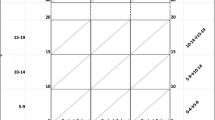Abstract
The Victorian Department of the Treasury has responsibility for preparation of demographic forecasts for use by state government departments and agencies. This paper provides a detailed description of the projection system and models developed by Treasury to produce population and household forecasts for the state, statistical divisions and statistical Local Areas of Victoria. Particular emphasis is given to use of a ‘tops down’ approach to integrate projections at different geographic levels, methods of reconciling forecasts of household growth with land supply and techniques used to project inter-SLA migration flows in a multi-regional cohort-component framework.
Similar content being viewed by others
References
Bell, M. 1992a.Demographic Projections and Forecasts in Australia, a Directory and Digest. Bureau of Immigration Research. Canberra: Australian Government Publishing Service.
Bell, M. 1992b,Internal Migration in Australia 1981–86. Bureau of Immigration Research. Canberra: Australian Government Publishing Service.
Davenport, P., D. Sams and J. O’Leary 1990. Small area estimates of the components of migration for Melbourne and suburban life cycles. Paper presented to the Australian Population Association Biennial Conference, Melbourne.
Department of Management and Budget (DMB). 1989a.Population and Household Projections for Australia, States and Territories, 1987 to 2011. Demographic Information Paper No. 1. Melbourne.
Department of Management and Budget (DMB). 1989b.The DMB Household Formation Model and Underlying Demand for Residential Building Activity. Demographic Information Paper No. 2. Melbourne.
Department of Management and Budget (DMB). 1989c.Projections of Dwelling Commencements, Households and Populations for Statistical Local Areas in Non-metropolitan Victoria. Demographic Information Paper No. 3. Melbourne.
Department of the Treasury (DOT). 1990.Projections of Dwelling Unit Commencements, Households and Populations for Statistical Local Areas in Metropolitan Melbourne. Demographic Information Paper No. 4. Melbourne.
Department of the Treasury (DOT). 1991.Revised Projections of Dwelling Unit Commencements, Households and Populations for Statistical Local Areas in Metropolitan Melbourne. Demographic Information Paper No. 5. Melbourne.
Department of the Treasury (DOT). 1992.Revised Projections of Dwelling Unit Commencements, Households and Populations for Australia, States and Territories, 1991 to 2031. Demographic Information Paper No. 6. Melbourne.
Flood, J., C. Maher, P. Newton and J. Roy. 1991.The Determinants of Internal Migration in Australia. Melbourne: CSIRO.
Fox, B. and A. Tuan-Mu. 1986,The LOPCON Projection Model. Melbourne: MMBW.
Indicative Planning Council for the Housing Industry (IPC). 1989.Long-Term Projections Report. Canberra: Australian Government Publishing Service.
Isard, W. 1960.Methods of Regional Analysis. Cambridge MA: MIT Press.
Logan, T., 1981.Urban and Regional Planning in Victoria. Melbourne: Shillington House.
Metropolitan Services Coordination System (MSCS). 1987.A Population and Household Forecast for Melbourne. MSCS Bulletin No. 1. Melbourne: Ministry for Planning and Environment.
Metropolitan Services Coordination System (MSCS). 1988.A Population and Household Forecast for Melbourne. MSCS Bulletin No. 2. Melbourne: Ministry for Planning and Environment.
Sams, D. and P. Davenport. 1988. Population and household forecasting. Paper presented to Australian Population Association, Population Workshop, July.
Sams, D. and P. Williams. 1983. The IMPACT population projection facility: a non-technical overview. IMPACT Working Paper No. B-22. Melbourne: University of Melbourne.
State Co-ordination Council, Victoria. 1982.Preliminary Population Projections, 1981–2001. Report by Forecasts Project Team. Melbourne: Department of Premier and Cabinet.
Willekens, F., A. Por and R. Raquillet. 1981. Entropy, multiproportional, and quadratic techniques for inferring patterns of migration from aggregate data. Pp.83–124 in IIASA Report No. 4.
Author information
Authors and Affiliations
Rights and permissions
About this article
Cite this article
Davenport, P., O’Leary, J. The victorian population projection framework. Journal of Population Research 9, 131–152 (1992). https://doi.org/10.1007/BF03029366
Issue Date:
DOI: https://doi.org/10.1007/BF03029366




